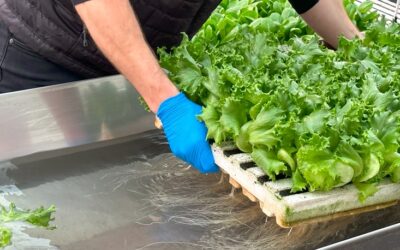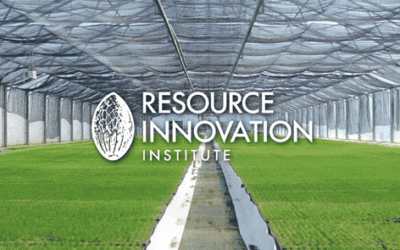WE INTERVIEWED EQUILIBRIUM’S CEO ABOUT THEIR NEW $1 BILLION CEA FUND. HERE’S WHAT HE HAD TO SAY.

Editor’s note: The following information is derived from an interview Agritecture conducted with Dave Chen, Chief Executive Officer at Equilibrium Capital, on the company’s recent $1.02B Fund for Indoor Ag.
The future of CEA – is it vertical farms or greenhouses?
If it was up to you, which would you choose? Both offer a year-round supply of fresh, pesticide-free, locally-grown produce. So, how would you choose between the two?
With the constant hype and appeal of growing vertically, most CEA newcomers tend to choose vertical farms, often thinking of greenhouses as the less innovative method.
Contrary to this way of thinking, Equilibrium Capital, a leading sustainability-driven investment management firm, is taking great interest in high-tech greenhouses.
Equilibrium recently announced the closing of their new Controlled Environment Foods Fund II (CEFF II) at $1.02 billion, allowing them to invest at a massive scale in mostly high-tech greenhouses across North America (The original CEFF, which closed at $336 million in April 2019, also focused on high-tech greenhouses).
Agritecture spoke with Dave Chen, CEO of Equilibrium. Despite their primary focus on greenhouses, one of the things Chen was adamant about was not pinning one form of sustainable growing against another. “We have artificially and mistakenly set this up as an ‘or’ statement – it’s either vertical farms or high tech glass greenhouses. I think the more appropriate way of thinking about it is that these are toolkits to help us solve the agricultural challenges in front of us.”
The Impact of COVID
It’s been 3.5 years since Equilibrium Capital made their first investment into the CEA space. Today “there’s a whole lot more people in it, and, there’s a lot more money running into it” relative to just a few years ago, per Chen.
A major change that has occurred in this time is that people have “a deeper understanding of the pervasive and invasive implications of climate change. And I think now folks really understand that agriculture is ground zero for climate.”
Responding to the effect of Covid-19, Chen says it’s much more complicated than the cliche narrative that consumers have grown more interested in healthy/safe eating and thus where their food comes from – in turn supercharging the demand for local production. “Fifty percent of our food dollars [typically] go through food services,” explains Chen, but “Covid immediately shifted where we ate, how we bought our food.” Suddenly, greenhouses, which had a much stronger footing in retail than food service, became a significant source of vegetable consumption because our dollars shifted so drastically from food service to retail.
Covid also gave a new face to resilience. “We saw that supply chain resilience was not just a fancy word, we actually saw the impact of Covid, both in terms of human labor that was available, and the shutdown of parts of the supply chain – we saw squeezes on the demand side and the supply side.”
To Equilibrium, this is proof that the conversation should really be about mass CEA production.

Image sourced from Equilibrium Capital
In thinking more specifically about food security, Chen steers the conversation towards how major investment dollars flowing to large-scale projects can enable the average middle-class consumer to afford CEA-grown produce and access it conveniently.
To understand the importance of mass production, Chen brings up one of the most powerful data collectors, Walmart. “Their average shopper in the US is middle-income and below. They’re budget shoppers on a fixed budget. If these shoppers are choosing to put greenhouse-grown vegetables in their cart, they have to be taking something out of their cart.” In other words, if the average Walmart customer is buying CEA-grown produce, it needs to be at price parity with conventional produce – otherwise, they’ll be cutting some other necessity out of their order.
For Chen, it’s not that farmers markets and specialty retailers don’t have a role to play. It’s simply that in order to feed the majority of consumers who don’t have the budget or the time to shop at a specialty market, you have to think BIG.
“Our largest projects are 100-120 acres in size,” says Chen, talking about Equilibrium’s portfolio farms. “They produce about 100 million pounds a year. That’s about 15 semi-trucks worth of vegetables a day.”
Urban <> Rural
With Equilibrium’s focus on such a mass scale, Chen believes that this can lend itself well for a rural farming renaissance, more so than an urban ag revolution.
Thinking of “rural equality, social equality, and the degradation of many of the farm economies globally as the youth leave, CEA, by means of technology, can be used to create a very different kind of work environment. It’s one with a low use of pesticides, herbicides, and fertilizers. So in many ways, it’s a safe environment, it’s year-round work, and it’s skilled work. The other exciting aspect is for regulators and government from a social policy standpoint – if you think about it, CEA employs people like water technicians, irrigation technicians, electricians, and machine programmers.” In other words, the types of high-paying jobs that can create more stable economies for rural parts of the country.
What impact does this have on employment?
“If you want a revolution, you have to motivate and enable the young. We certainly see that happening here in the sector.”
Looking back on a conversation with one of the largest high-tech field farmers in the US, Chen shares: “I asked this individual where he got his up-and-coming farm managers and tactical managers from. And, he made the comment that they weren’t really hiring as much from agricultural universities and ag programs. They were looking for primarily women coming from engineering and biology backgrounds – the sciences. His comment was that the field of agriculture was becoming more and more about the willingness to learn and adapt, and the candidate’s comfort with technology and data.”
“I’m seeing the same thing happening in CEA. The kinds of folks that are coming into CEA are coming from a variety of backgrounds. They’re exhibiting the fact that the opportunity to contribute, and not just do it the way that we have always done it, but into a field that’s new, is there.”
Does this focus on rural economies conflict with the hyperlocality focus that is so often cited as a major benefit for CEA?
Insights for the future
What do most investors get wrong about CEA? we asked.
“There’s a tendency to focus on the word ‘control’ in controlled environment agriculture. It’s not three tubes on one side of the wall where you put seeds, fertilizer, and water, and the tomato pops out the other end. It is still execution-intensive agriculture.”
How about the next crop or crop type that will be well-established in CEA, five years from now?
“I think that we will take a page out of Northern Europe, and we will address the North American soft fruit market – the berries, traditional field crops like blueberries will start to come indoors for the advantages of what controlling the environment can do even for a woody species. The ability to control the environment for quality ripening, as well as the new genetic varieties are compelling. We’ll see melons go indoors, alongside the entire suite of herb-like vegetables, all the way through to things like vanilla beans.”






